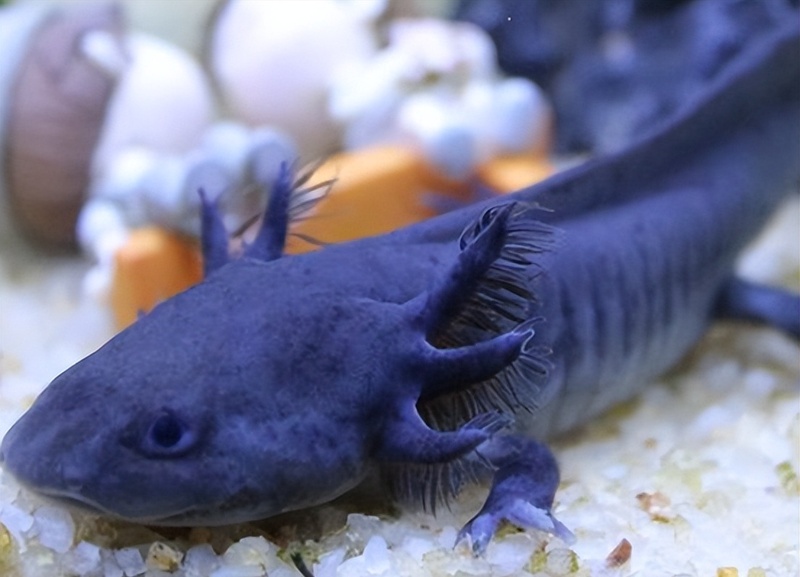The blue axolotl is one of the most unique and captivating creatures in the animal kingdom. Known for its striking color and rare traits, this amphibian has become a favorite among aquarists and biology enthusiasts. But what exactly is a blue axolotl, and why does it stand out? In this article, we will explore the biology, habitat, care, and cultural significance of the blue axolotl, shedding light on why it has captured so much attention.

The blue axolotl is a color variation of the axolotl (Ambystoma mexicanum), a species of aquatic salamander native to Mexico. Below is its scientific classification:
Kingdom: Animalia
Phylum: Chordata
Class: Amphibia
Order: Urodela
Family: Ambystomatidae
Genus: Ambystoma
Species: Ambystoma mexicanum
Unique Coloration:
The blue axolotl, often referred to as "melanoid blue," features a dark blue to blackish hue that distinguishes it from other axolotl color morphs.
External Gills:
Like other axolotls, the blue axolotl has feathery external gills that allow it to breathe underwater.
Size:
They typically grow to about 9–12 inches (23–30 cm) in length.
Lifespan:
In captivity, a well-cared-for blue axolotl can live up to 15 years.
The blue coloration in blue axolotls results from a combination of genetics and melanin concentration. This rare morph is a favorite among hobbyists for its striking appearance and rarity.
The blue axolotl, like all axolotls, is native to the lakes and canals of Mexico, particularly:
Lake Xochimilco: The primary habitat for wild axolotls.
Lake Chalco: Historically home to axolotls, though this lake has been drained.
Water Conditions:
Blue axolotls thrive in cool, freshwater environments with a temperature range of 60–68°F (16–20°C).
Vegetation:
They prefer habitats with aquatic plants for cover and hunting.
Water Quality:
Clean, well-oxygenated water is essential for their survival.
Pollution:
Urbanization and agricultural runoff have polluted the blue axolotl’s natural habitat.
Invasive Species:
Non-native fish species compete for food and prey on axolotl eggs and larvae.
Habitat Loss:
Draining of lakes and canals has significantly reduced their wild populations.
Unlike most salamanders, which undergo metamorphosis, the blue axolotl remains fully aquatic throughout its life, retaining its larval features in a condition called neoteny.
Carnivorous Feeding:
Worms
Crustaceans
Small fish
Insect larvae
Blue axolotls are carnivorous and feed on small aquatic organisms such as:
Hunting Style:
They use suction feeding to capture prey, drawing food into their mouths with a quick gulp.
Solitary Nature:
Blue axolotls are generally solitary and prefer minimal interaction with other axolotls.
Breeding Behavior:
During mating, males deposit spermatophores, which females pick up to fertilize their eggs.
Tank Size:
A minimum of 20 gallons (75 liters) is recommended for a single blue axolotl.
Substrate:
Use fine sand or a bare-bottom tank to prevent impaction, as they may accidentally ingest gravel.
Filtration:
A gentle filter is essential to maintain water quality without creating strong currents.
Temperature:
Keep the water between 60–68°F (16–20°C).
pH Level:
The ideal pH range is 6.5–8.0.
Ammonia and Nitrite:
Ensure these levels remain at 0 ppm through regular water changes.
Staple Foods:
Offer live or frozen foods such as bloodworms, brine shrimp, and blackworms.
Supplementary Foods:
Pellets designed for carnivorous fish can be included in their diet.
Feeding Frequency:
Feed adult blue axolotls 2–3 times per week.
Blue axolotls are best kept alone, as they may nip at tank mates, and smaller companions may be seen as food.
While the blue axolotl is not found in the wild, its species, the axolotl, is critically endangered due to:
Habitat Loss:
Urban development in Mexico City has severely reduced their natural habitat.
Overharvesting:
Axolotls are collected for traditional medicine and the pet trade.
Climate Change:
Rising temperatures threaten their cool water habitats.
Captive Breeding:
Programs in zoos and aquariums help maintain genetically diverse populations.
Habitat Restoration:
Efforts are underway to clean and restore Lake Xochimilco.
Public Awareness:
Campaigns highlighting the plight of the axolotl aim to garner support for conservation initiatives.
The axolotl holds a significant place in Aztec mythology, where it is associated with Xolotl, the god of fire and lightning, who transformed into an axolotl to avoid sacrifice.
Video Games:
Blue axolotls gained popularity as a rare mob in games like Minecraft.
Social Media:
Their adorable appearance has made them a trending topic on platforms like Instagram and TikTok.
Regenerative Powers:
Blue axolotls can regenerate lost limbs, gills, and even parts of their heart or brain.
Permanent Smile:
Their facial structure gives them a "smiling" appearance, contributing to their charm.
No Metamorphosis:
They retain their larval features throughout their lives due to neoteny.
Unique Genetics:
The blue coloration is rare and highly sought after in the pet trade.
Popularity in Science:
Blue axolotls are used in medical research due to their regenerative abilities.
The blue coloration results from specific genetic traits that influence melanin concentration in their skin.
While possible, it’s best to house them separately to avoid aggression or stress.
With proper care, they can live up to 15 years in captivity.
Blue axolotls are bred in captivity, as this coloration does not occur naturally in the wild.
Yes, with the right knowledge and setup, they make excellent pets for beginners.
The blue axolotl is a truly remarkable creature that combines stunning beauty with fascinating biology. From their vibrant appearance to their regenerative abilities, these amphibians captivate the hearts of scientists and pet enthusiasts alike. However, their existence highlights the importance of conservation, as wild axolotls face numerous threats. By understanding and appreciating the blue axolotl, we can contribute to their preservation and enjoy the company of one of nature’s most extraordinary species.
animal tags: blue-axolotl
We created this article in conjunction with AI technology, then made sure it was fact-checked and edited by a Animals Top editor.